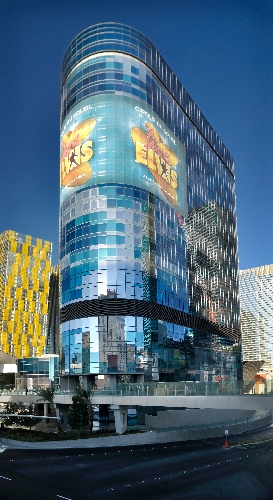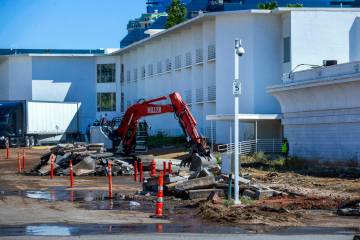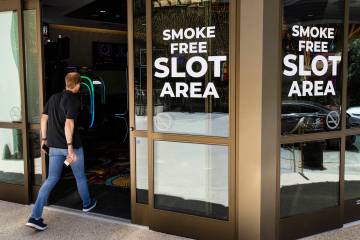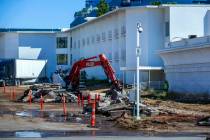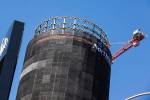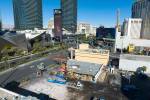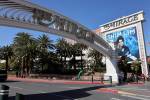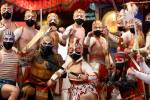Harmon Hotel stuck in limbo
CityCenter's most famous architect is also its least publicized. His name is Norman Foster. He is a globetrotting superstar with books and museum exhibits dedicated to his work. "Stormin' Norman," as the British press calls him, serves as chairman of London-based Foster + Partners, an architecture, design and planning firm responsible for famous buildings across Europe and Asia, including the Hongkong and Shanghai Bank headquarters and Reichstag New German Parliament. The Harmon Hotel at CityCenter was to be Foster's Las Vegas debut.
Owner MGM Resorts International was excited about Foster's involvement at CityCenter; it gave his oval-shaped blue-glass building design Strip-front placement. The Light Group, best known for operating trendy nightclubs and chic restaurants, was tapped to foster "a-place-to-be-and-be-seen image" at Harmon while catering to "a young and wealthy demographic," MGM Resorts said.
Harmon seemingly had it all -- pedigree, a flashy design and great location. Yet, completion of the still-unfinished building is uncertain. Foster, whose project involvement once figured prominently in CityCenter's marketing and promotional material, was absent from the Dec. 16 grand-opening festivities. The Harmon website is offline. Today, the Harmon lies at the center of a bitter legal fight between MGM Resorts and CityCenter general contractor Perini Building Co. Much of the spat centers on defective construction, and who is responsible for what. Millions of dollars are at stake.
SOLID BEGINNING
Things started fine with the Harmon, one of six high-rise buildings at CityCenter's 67-acre campus. The 47-story mixed-use tower officially broke ground in 2006 at the northeast corner of Harmon Avenue and Las Vegas Boulevard amid fanfare and great expectations. Construction progressed and the building took shape, steadily climbing skyward. Plans called for 207 posh residences perched above a 400-room hotel, with a Mr. Chow's Restaurant and Frédéric Fekkai salon, among other amenities.
Trouble surfaced in July 2008 when it was learned that rebar -- reinforcing steel bars used in concrete -- was improperly installed on 15 floors of the building. The discovery resulted in a temporary project shutdown and construction repairs. Clark County's Building Department launched an investigation, as did the Nevada State Contractors Board.
They found that the Harmon's third-party inspection firm, Monrovia, Calif.-based Converse Consultants, falsified 62 daily reports between March and July of 2008 stating that things were OK when they weren't. County inspectors missed the problems, too. It seems rebar was misplaced inside link beams that transfer horizontal loading to the building's shear walls. A shear wall is a braced panel wall that counters lateral loads on a structure. In other words, it supports the building and keeps it from falling over.
Stirrup hooks, ties that hold rebar together, also were spaced incorrectly, county investigators found; some even poked past the floor slab, prompting workers to cut them off with a blowtorch so they wouldn't show.
"We do not see this very often," county building official Ron Lynn said. "They installed it wrong. That's the bottom line."
Perini and subcontractor Pacific Coast Steel began fixing the mistakes. Converse Consultants, meanwhile, was suspended from seeking new work in Southern Nevada for six months; its inspectors had their qualifications revoked and suspended. In April 2009, Pacific Coast Steel paid $14,105 in fines after a Contractors Board investigation found "substandard workmanship" issues. The firm did not admit fault as part of a settlement. Perini also paid administrative fines, though it did not admit fault either.
"We have been really straightforward with (MGM Resorts) on Harmon. We acknowledged that there was work that wasn't done right and we said that we would fix things," Perini President and CEO Craig Shaw said. "We have paid $6 million ourselves to fix Harmon; Pacific Coast Steel is out of pocket $4 million."
Harmon's design called for pouring top portions of the 8-foot-thick link beams with the floor slab, which is a tricky procedure given the tight and exact spacing of rebar. Foster is known for complex, technical buildings that often have unusual and daring shapes. One of the company's most popular creations, London's Swiss Re Tower, for example, is shaped like a gherkin.
Harmon workers reportedly moved rebar without first getting an OK from the structural engineer, Halcrow Yolles, which is a major no-no in the construction chain of command. Rebar placement is carefully configured to maximize structural building strength.
"Congestion, or too much rebar matted together, prevented proper coverage and distribution of concrete," said a project official who requested anonymity.
MGM Resorts Senior Vice President of Public Affairs Alan Feldman said: "Perini and PCS acknowledged that substandard supervision and substandard workmanship were at issue at the Harmon without any reference to design drawings.
"Furthermore, Perini has sued its subcontractor Pacific Coast Steel for the link-beam defects at the Harmon."
Perini counters that structural drawings for Harmon "were months late and contained many errors and omissions," adding that MGM Resorts "would have to acknowledge that the permitted set of drawings never matched the sets of drawings (used) to construct the project."
MGM Resorts, meanwhile, announced in January 2009 that Harmon would be only about half of its planned height. The company was eliminating 207 condominiums, of which less than half had sold, and shrinking the building size to 26 stories. MGM Resorts said the move saved $600 million in construction costs and deferred $200 million in expenses.
A year earlier, the Harmon had been expected to "define a new era of sustainable luxury," Light Group principal partner Andrew Sasson said, calling it "an amalgamation of every great lifestyle experience in the world, only better."
But a scaled-back Harmon was still proceeding; it was expected to open in late 2010, or about a year after the rest of CityCenter. Perini calls the building reduction a "unilateral decision" motivated by economics. MGM Resorts lost $96.7 million in the first quarter, partly due to an $86 million write-down of CityCenter residences, U.S. Securities Exchange Commission filings show.
"MGM (Resorts) officials admitted several times that this decision was based on deteriorating condominium and cash-flow considerations rather than any alleged construction defect," Shaw said. "MGM (Resorts) acknowledged that the issues were fixable in late February 2010."
But Feldman countered: "(It) was necessary because of defective work by Perini and its subcontractors."
It was about this time that talks between MGM Resorts and Perini deteriorated. Harmon started being called a "total loss" by MGM Resorts management, Perini claims. On March 23, MGM Resorts directed security guards to escort Perini from the Harmon jobsite and changed the locks. Construction came to an abrupt halt.
Harmon's completion has been postponed indefinitely. Today, it sits dormant with a wrap sign for CityCenter's "Viva Elvis" show plastered across its façade. Harmon may be the world's most expensive billboard.
MGM Resorts has withheld payment on $490 million in construction bills. Perini filed a master mechanics' lien and a lawsuit; MGM Resorts responded with a counterclaim. Like a bad divorce, this fight could be lengthy, ugly and expensive.
"CityCenter estimates its damages against Perini for the defective Harmon alone will be in the millions of dollars," states MGM Resorts' counterclaim, due to an "abject failure to properly construct Harmon."
Perini rejects the idea, calling it a "smoke screen" to avoid payment.
"It doesn't get any more obvious as to why they have contrived this theory," Shaw said. "They either don't want to or don't have the ability to pay."
Contact reporter Tony Illia at tonyillia@aol.com or 702-303-5699.
HARMON TIMELINE
June 2006
Harmon officially breaks ground
Jan. 15, 2008
Harmon launches condo sales push
July 2008
Rebar mistakes discovered at Harmon
Jan. 7, 2009
MGM Resorts International kills Harmon condos, delays opening until late 2010
Dec. 16, 2009
CityCenter grand opening
March 24, 2010
Perini Building Co. sues owners of CityCenter
March 29, 2010
Perini files mechanic's lien against CityCenter
June 2, 1010
MGM Resorts files counterclaim against Perini
June 28, 2010
Court date to consolidate case




